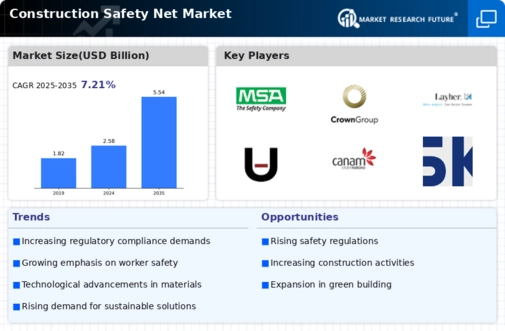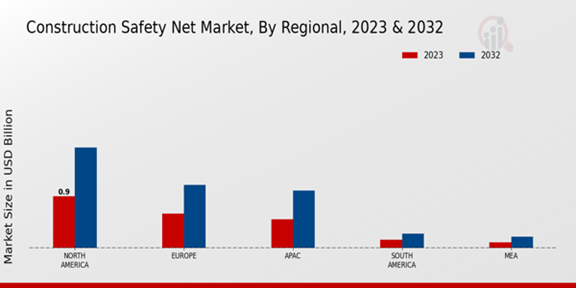Global Economic Growth
The Global Construction Safety Net Market Industry is closely tied to global economic growth, which influences construction spending and investment. As economies recover and expand, construction projects proliferate, necessitating enhanced safety measures. The increasing number of infrastructure projects, particularly in developing regions, creates a favorable environment for safety net adoption. This trend is expected to contribute to the market's growth trajectory, with projections indicating a market value of 2.58 USD Billion in 2024. As economic conditions improve, the demand for safety nets is likely to rise, reflecting the industry's commitment to ensuring worker safety amidst expanding construction activities.
Market Growth Projections
The Global Construction Safety Net Market Industry is projected to experience substantial growth in the coming years. With a market value of 2.58 USD Billion in 2024, the industry is expected to reach 5.54 USD Billion by 2035, indicating a robust expansion. This growth is underpinned by a compound annual growth rate (CAGR) of 7.2% from 2025 to 2035. Factors contributing to this growth include increasing construction activities, stringent safety regulations, and rising awareness of worker safety. As the industry evolves, the demand for innovative safety solutions, including advanced safety nets, is likely to shape the future landscape of construction safety.
Technological Advancements
Technological advancements play a pivotal role in shaping the Global Construction Safety Net Market Industry. Innovations in materials and design have led to the development of more durable and effective safety nets. For example, the introduction of high-strength synthetic fibers has improved the performance and longevity of safety nets, making them more appealing to construction companies. These advancements not only enhance worker safety but also reduce costs associated with accidents and injuries. As the industry embraces these technologies, the market is likely to experience a compound annual growth rate (CAGR) of 7.2% from 2025 to 2035, reflecting the growing importance of safety in construction.
Stringent Safety Regulations
The Global Construction Safety Net Market Industry is significantly influenced by the implementation of stringent safety regulations across various countries. Governments are increasingly mandating the use of safety nets to mitigate risks associated with construction work. For instance, the Occupational Safety and Health Administration (OSHA) in the United States enforces regulations that require safety nets on construction sites where workers are at risk of falling. This regulatory environment fosters a culture of safety, compelling construction firms to invest in safety net solutions. As a result, the market is expected to grow, with projections indicating a value of 5.54 USD Billion by 2035.
Rising Awareness of Worker Safety
The Global Construction Safety Net Market Industry is benefiting from a heightened awareness of worker safety among construction firms and stakeholders. As incidents of workplace injuries garner media attention, there is a growing recognition of the need for effective safety measures. This awareness drives demand for safety nets as a proactive solution to prevent falls and injuries. Training programs and safety campaigns further reinforce this trend, encouraging companies to prioritize safety in their operations. Consequently, the market is poised for growth, with an anticipated increase in investment in safety net solutions to protect workers and comply with evolving safety standards.
Increasing Construction Activities
The Global Construction Safety Net Market Industry is experiencing growth driven by an upsurge in construction activities worldwide. As urbanization accelerates, the demand for residential and commercial buildings rises, leading to a projected market value of 2.58 USD Billion in 2024. This growth necessitates enhanced safety measures, including the use of safety nets to protect workers from falls and other hazards. Countries with robust construction sectors, such as the United States and China, are particularly contributing to this trend. The emphasis on safety regulations further propels the adoption of safety nets, ensuring compliance and reducing workplace accidents.












